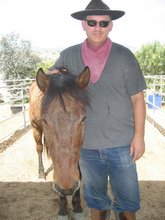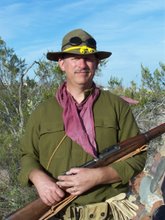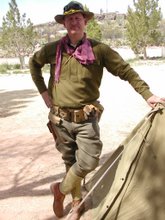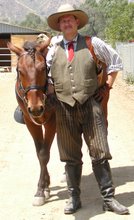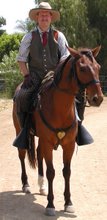This weekend was a busy one for both Max and I to include Max and I performing with the Warhorse Foundation at a fund-raising event for charity at Moonshadow Ranch in Shadow Hills. This was a "debut" of sorts for Max and I in that while we'd practiced off and on the musical ride program that the group uses, it had been quite awhile since we'd done so and I was COMPLETELY rusty at it.
Additonally, because of scheduling issues, the group hadn't practiced the standard musical ride routine so early Saturday morning found us practicing over at Gabriellano Park in the arena (I almost live there, it seems). While Max and I did all the basic moves pretty decently, we were completely messing up on the actually routine (turning the wrong way, mis-judging distances, etc). It also didn't help that Saturday was the real first "hot" day of summer and it was getting miserable by the time we ended practice (after two hours).
Then, there was the issue of logistics. It seems that for every hour actually performing or "doing something", there's three hours preparation. We were scheduled to perform at about 7:30 and were supposed to be at Moonshadow Ranch by 4:30 and we were going to ride over...well, that was the plan anyway.
Due to a number of snafus, it turned out that we were going to trailer the horses over and we didn't actually get on the road until 5 PM. Then there was the task of finding a place to park. There's not a lot of room at Moonshadow Ranch so we wound up parking on a side street behind the ranch and tying up the horses and prepping them on the street (which for a dead-end street was like a major freeway! Go figure...). After having to constantly stop and move the horses to allow cars and trucks to pass, we finally were ready and we rode about two blocks to the entrance. We then had to wait additional time until we were "on".
This was an interesting exercise for Max because our assembly area was basically in the main driveway leading into the ranch and that driveway was pretty narrow so there were people walking past us on both sides and naturally, many wanted to pet Max. Max pretty much tolerated the people (it was a good crowd and many are horse people) and Max seemed to do his best to act charming, hoping to score a carrot or two (what a pimp!). The ladies seemed to especially like him...go figure!
Finally it was our time to go on and we had to make our way down the narrow driveway and then through a crowd to the arena entrance.
We managed to form up properly, just as we'd rehearsed. Unfortunately, the one horse next to Max decided to act up and was completely disagreeable- guess he was excited by the whole thing. This kicked in just as we were starting so while the other rider did her best to keep things under control, I now had to to keep an eye on that situation, while at the same time looking for all my cues and to hit my mark on time.
For the most part, I was able to execute the routine with little problem and while I did make some mistakes, they were not major. It also didn't help having to deal with the disagreeable horse who wouldn't keep his place in line and one other rider who was dragging along at a slow pace, thereby messing up my spacing. Oh well- just goes to show the need for PRACTICE! PRACTICE! PRACTICE!
At several points we had to canter and Max especially liked this part- he was completely "on" and it he seemed to almost be projecting himself, saying "I'm so cool!" to the crowd. The crowd didn't seem to affect him any and he didn't mind riding up close to them at the rail.
Hopefully I'll have some pictures to post soon but overall it was an excellent experience and hopefully will lead to more and better things.
Now to collect up all my tack that seemed to have gotten scattered about. :-)
Additonally, because of scheduling issues, the group hadn't practiced the standard musical ride routine so early Saturday morning found us practicing over at Gabriellano Park in the arena (I almost live there, it seems). While Max and I did all the basic moves pretty decently, we were completely messing up on the actually routine (turning the wrong way, mis-judging distances, etc). It also didn't help that Saturday was the real first "hot" day of summer and it was getting miserable by the time we ended practice (after two hours).
Then, there was the issue of logistics. It seems that for every hour actually performing or "doing something", there's three hours preparation. We were scheduled to perform at about 7:30 and were supposed to be at Moonshadow Ranch by 4:30 and we were going to ride over...well, that was the plan anyway.
Due to a number of snafus, it turned out that we were going to trailer the horses over and we didn't actually get on the road until 5 PM. Then there was the task of finding a place to park. There's not a lot of room at Moonshadow Ranch so we wound up parking on a side street behind the ranch and tying up the horses and prepping them on the street (which for a dead-end street was like a major freeway! Go figure...). After having to constantly stop and move the horses to allow cars and trucks to pass, we finally were ready and we rode about two blocks to the entrance. We then had to wait additional time until we were "on".
This was an interesting exercise for Max because our assembly area was basically in the main driveway leading into the ranch and that driveway was pretty narrow so there were people walking past us on both sides and naturally, many wanted to pet Max. Max pretty much tolerated the people (it was a good crowd and many are horse people) and Max seemed to do his best to act charming, hoping to score a carrot or two (what a pimp!). The ladies seemed to especially like him...go figure!
Finally it was our time to go on and we had to make our way down the narrow driveway and then through a crowd to the arena entrance.
We managed to form up properly, just as we'd rehearsed. Unfortunately, the one horse next to Max decided to act up and was completely disagreeable- guess he was excited by the whole thing. This kicked in just as we were starting so while the other rider did her best to keep things under control, I now had to to keep an eye on that situation, while at the same time looking for all my cues and to hit my mark on time.
For the most part, I was able to execute the routine with little problem and while I did make some mistakes, they were not major. It also didn't help having to deal with the disagreeable horse who wouldn't keep his place in line and one other rider who was dragging along at a slow pace, thereby messing up my spacing. Oh well- just goes to show the need for PRACTICE! PRACTICE! PRACTICE!
At several points we had to canter and Max especially liked this part- he was completely "on" and it he seemed to almost be projecting himself, saying "I'm so cool!" to the crowd. The crowd didn't seem to affect him any and he didn't mind riding up close to them at the rail.
Hopefully I'll have some pictures to post soon but overall it was an excellent experience and hopefully will lead to more and better things.
Now to collect up all my tack that seemed to have gotten scattered about. :-)

























